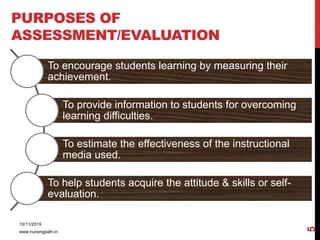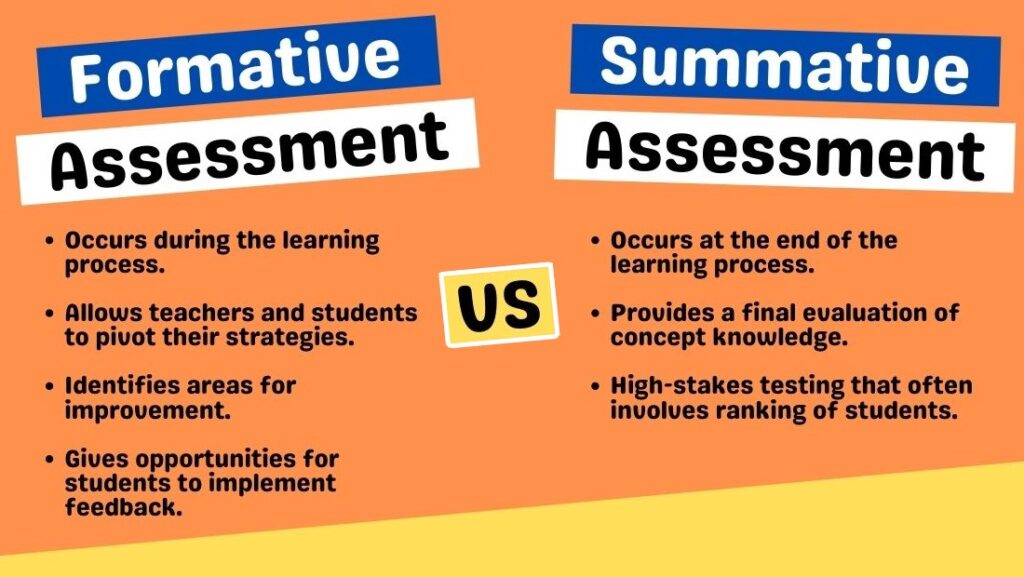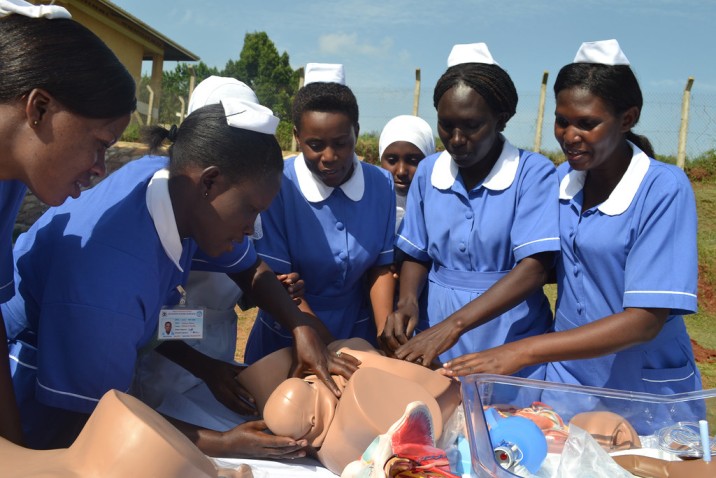Table of Contents
ToggleASSESSMENT AND EVALUATION
INTRODUCTION
Education is an activity in which a variety of resources are put, these resources include money, time, labor, instructional materials, etc. We need to find out whether we are benefiting from putting all these resources into the education of our learners. To do this, we use measurement, assessment, testing, and evaluation.
Evaluation
Evaluation is the systematic process of collecting, analyzing, and interpreting information that determines the effectiveness (value) of an educational program in the light of evidence obtained through research, assessment, measurement, testing, experimenting, and consulting. Thus, evaluation can also be defined as the process of judging the value or worth of an individual’s achievements. It attempts to provide useful feedback information to stakeholders. It facilitates the judgment of what extent the educational objectives have been met.
Assessments
In education, the term assessment means the process of documenting in quantitative terms the knowledge, skills, and values attained by the learner. Currently in Ugandan higher institutions, there is continuous assessment being emphasized. The results of continuous assessment help teachers keep an accumulative record that may be used to assess the overall performance of the learner.
Testing
This is a way of discovering by questions or practical activities what someone knows or what someone can do. Educationally, we test our learners to find out how much knowledge and skills they possess, and what values and attributes they have developed.
Measurement
This refers to assigning numbers to a learning program or event in order to describe or represent the amount of abilities, characteristics, and potential possessed by a learner. Measurement describes a situation in quantitative terms, while evaluation judges its worth or value in qualitative terms, such as good or poor.

PURPOSE / AIMS OF ASSESSMENT AND EVALUATION
Diagnosis: It helps us to understand the problem existing within the program; therefore, appropriate action can be taken.
Placement and Promotion (Selection): It helps us correctly find where the individual should belong, i.e., who can be promoted to another class or who goes for which course based on aggregates, e.g., primary leavers are selected according to aggregate got, i.e., whether a student of aggregate 6 can go to Kisubi or whether a student who did MEG can do law.
Certification: It is the only way one can satisfy the assessment committee to provide evidence about the attainment of a particular skill, e.g., a degree certificate, driving permit, etc.
Standards: It helps the teachers to establish a reference point, i.e., the minimum entry point, e.g., At UNMEB exams, a standard is 50% in every paper, which was determined based on how students used to score in the past.
Prediction: The stakeholders are able to determine the future potentials/weaknesses of individuals, e.g., a student who performs well in Physics is likely to be an engineer.
Refinement: The information from the evaluation can help us to improve on the programs by identifying where we are weak. E.g., a teacher looks at the students’ work and sees what topic they have failed, then the teacher tries to simplify his/her teaching.
Norms referencing: It helps us to compare an individual against other individuals or against the system. E.g., a student in the 5th position out of 40 students can be determined by assessments.
Remediation: Results of assessment are a basis for correcting learning responses and clarification of misconceptions. A teacher might decide to organize a remedial class to correct the challenges that students faced during assessments.
Motivation: Feedback from assessment is motivation for future aspiration among learners. For example, a student can be motivated to read harder after good performance in an exam.
FACTORS TO CONSIDER WHEN SELECTING A TOOL OF ASSESSMENT
Purpose of evaluation: In the evaluation of learners’ progress, one should first identify the learning outcomes to be measured. For example, in nursing education, outcomes could be that learners should possess knowledge in disease management, skills in nursing procedures, and a good attitude in patient care.
Availability of assessment tools: No single evaluation tool is adequate for assessing learners’ progress; make sure you use a variety of techniques to obtain a complete picture of the students’ achievements. Use what is available and can be administered to the learners. For example, a theory exam can evaluate learners’ knowledge, and a practical exam evaluates their skills and attitudes.
Validity: It is a concern about how well the test measures what it is supposed to measure. For example, measuring students’ intelligence using a tape measure around the circumference of the head will not provide accurate measurements of intelligence, so the validity of this tool will be weak.
Reliability: It measures how consistent the scores obtained by different examiners are, determining how stable a measurement is.
Practicality: Refers to the action of the assessment method and its relevance to the overall learning goals in the course, addressing whether or not the workload for the instructor is reasonable.
Ease of interpretation of results: The evaluation tool used should enhance the teacher’s ability to interpret the results for student performance.
Time frame: The available time determines which evaluation tool to use, allowing students to complete the assigned tasks in an appropriate time.
Costs and resources available: The evaluation should use techniques that are economical and require little funds, human resources, and time.

TYPES/FORMS OF ASSESSMENT/EVALUATION
There are two major forms to evaluate a student’s learning:
Formative Assessment:
- This is a form of assessment that allows the teacher to check for student understanding along the way, as the lesson or unit is being taught.
- In the day-to-day teaching, teachers continuously check on how students are learning. This includes the questions they ask when teaching, the exercises they give, homework, weekly tests, etc.
Functions of Formative Assessment:
- It gives teachers the ability to provide constant feedback to the students.
- It allows the students to be part of the learning environment and to develop self-assessment strategies that will help with the understanding of their own thought process.
- Yields decisions on the improvement of content delivery.
- It determines which objectives individual students have achieved.
- It ensures that students have learned certain things before they progress to the next level.
Summative Assessment:
- This refers to the assessment of participants where the focus is on the outcome of a program. It evaluates student learning, skill acquisition, and academic achievement at the conclusion of a defined instructional period, e.g., PLE, UACE, end-of-year exams.
INTERPRETATION OF MEASUREMENT
There are two types of interpreting measurements:
Norm-Referenced Measurement:
- The norm-referenced approach involves comparing the scores of an individual with those of other learners in the same category.
- It helps differentiate among individuals by comparing the position of one individual against others in the same group.
- For example, a score of 70% by Agnes may place her in the 2nd position in that group, while a score of 84% by Mary in another group may place her in the 10th position.
Criterion-Referenced Measurement:
- These measurements are designed to measure student performance against a fixed set of predetermined criteria or learning standards.
- It does not concern itself with other students but rather focuses on an individual.
- It’s concerned about what one can and cannot do.
- For example, the UNMEB examination system has a pass mark of 50%, where one can be considered to have failed (if below 50%) or passed (if above 50%).
CLASSROOM ASSESSMENT TECHNIQUES/TOOLS THAT CAN BE USED IN HEALTH TRAINING INSTITUTIONS
There are various ways through which assessment and evaluations can be conducted in classrooms. These include:
a) Observation
b) Oral examinations
c) Written examinations
d) Practical examinations
OBSERVATION
Observation involves assessing one’s academic progress based on observation by the teacher.
It can involve seeing students’ behavior and listening to oral contributions to evaluate the learners’ attitude, learning speed, style, intelligence, personal abilities, and progress. This technique can detect problems immediately so that corrective measures can be employed, but it’s prone to prejudice and bias from the teacher as the observer.
ORAL EXAMINATIONS
Oral examinations involve a face-to-face question and answer between the teacher (examiner) and the student (examinee).
The teacher asks questions and finally scores the candidate based on the quality of the responses from the learner. Examples include interviews, quizzes, panel discussions, case presentations, etc. In nursing, traditional oral practical exams were conducted where the teacher would vary questions asked from one student to another.
WRITTEN EXAMINATIONS
Teacher-made tests are the most widely used written examination for assessing learning. The construction of these tests fundamentally depends on the teacher and can be categorized into two types: Objective and Subjective tests.
OBJECTIVE TESTS
Objective tests predominantly assess using short responses or answers. They include multiple-choice, true/false (binary test), matching, and completion (fill-in) questions.
Multiple Choice Questions (MCQ’s):
MCQs present a statement or question to which several responses are given, with only one response being correct. The statement/item is referred to as the stem, the correct response as the Key, and other options or alternative responses as destructors.
Guidelines for Preparing Meaningful MCQs
- Use simple vocabulary.
- Ensure the stem is clear and specific.
- Make sure the destructors are capable of separating.
- Avoid questions that measure opinions or judgments.
- Use numerical answers in ascending order.
- Avoid providing insight/idea to the answer while writing the stem.
- When using words like NOT or EXCEPT, they should be bolded or underlined.
Matching Items
Matching items present students with a list of statements and a list of responses, with a set of directions for matching them.
Guidelines for Preparing Matching Tests
- Use homogeneous options/items.
- Provide clear directions to students on how to match the responses.
- Avoid the use of specific determiners that may provide clues to the responses.
Binary Test
This type involves a statement or item to which judgment is made either in agreement or disagreement, typically with forms like true or false, agree or disagree, and yes or no.
Guidelines for Binary Test Preparation
- Use clear and understandable language. Try always to avoid words that are partly true and partly false.
- Avoid using negative statements. e.g. Kerosene is not a solid. True/False.
- Avoid long, complex sentences.
- Avoid including 2 or more ideas in one sentence e.g Gentamycin is an antibiotic that is given by I.V. true/false
- Don’t use terms that provide clues about the right answer. Words like NEVER, NONE, OR, e.t.c. which are likely to be false. On the other hand, words like Sometimes, Usually, Likely…
- Avoid copying statements from textbooks.
- Vary options to avoid guesswork.
- Have an equal number of true and false questions to prevent guesswork.
Completion/Fill-in-Blanks Tests
Such a test requires that spaces are left between the items so that the respondent can fill them in with one word or many words.
Guidelines for Fill-In Test Preparation (Completion/Fill-in-Blanks Tests)
Such a test requires that spaces are left between the items so that the respondent can fill them in with one word or many words.
- Construct items that measure important objectives in the area of study.
- Pose specific problems to the examinees so they give brief and specific responses.
- Use precise and accurate language in the questions.
- Ensure the expected answers from students are factually correct.
- Avoid using too many blanks.
- Put blank spaces at the end rather than starting questions with them.
- Avoid using exact statements as they appear in the notes to prevent guesswork.
- Preferably use statements that require one correct answer, not many.
- Have a wide scope of content coverage.
- Avoid questions that require lengthy answers; use statement definitions instead, e.g., the process of allocating marks to different questions in a test is called.
Merits of Objective Tests
- Easy to assess, correct, and mark.
- Balancing and controlling the level of difficulty is feasible.
- Provides a high level of reliability.
- Encourages extensive work from students.
- Reduces speculation among students.
- Offers a wide scope of content and syllabus coverage.
Demerits of Objective Tests
- Difficult to prepare.
- Susceptible to guesswork.
- Does not encourage higher-order thinking like subjective tests.
- Does not provide an opportunity for planning and organizing.
- Measures superficial knowledge of the student.
SUBJECTIVE TESTS
This is a mode in which each question or item requires an elaborate description and explanation. Therefore, there is no exact or simple answer. They include short-answer and essay items.
Short-Answer Items:
- Requires students to supply a word, short phrase, number, or other type of brief response. E.G List 4 characteristics of adult learners
Essay Items:
- Essay items require students to write paragraphs or develop themes as responses. They involve a wider variety of thinking skills, as students must recall, select, organize, and apply.
Guidelines for Preparing a Good Subjective Assessment
- Keep questions focused and specific.
- Use grammatical expressions at the level of the students (e.g., list, outline, state). Avoid vague expressions like mention, identify, tell us, show us.
- Consider the available time for taking the test.
- Allocate marks for each item (e.g., a) Define the term memory (1 mark), b) Describe the relationship between memory and learning (5 marks).
- Avoid compounding items (e.g., Discuss the structure, function, and adaptations of the liver [25 marks]). Break it into parts (a) Describe the structure of the liver [7 marks], b) Outline the functions of the liver [10 marks], c) Illustrate the adaptations of the liver for its functions [8 marks].
Advantages of Subjective Tests
- Measures the evidence of clear understanding of the content.
- Relatively easy to construct and prepare.
- Allows for critical and high-order thinking.
- Assesses the ability to organize one’s own ideas.
- Tests skills of analysis and planning.
- Measures divergence in thinking.
Limitations
- Poor content coverage.
- Promotes speculations among test takers.
- Time-consuming to score and not always reliable.
- May be influenced by bias, such as handwriting, language used, or the test taker’s personal information.
- Can be misinterpreted by the test taker.
PRACTICAL EXAMINATIONS
- Practical examinations are used to evaluate nursing competence in practical skills. Currently, Objective Structured Clinical/Practical Examination (OSCE/OSPE) is the test method used in nursing education to assess practical skills.
- Examiners use a checklist to evaluate trainees, providing the same problem and tasks to all students within the same time frame. The tasks simulate real clinical situations, including history taking, physical examinations, simple procedures, interpretation of lab results, patient management problems, communication, and attitude, among others. All students are assessed on the same criteria using a checklist by the same examiners.


